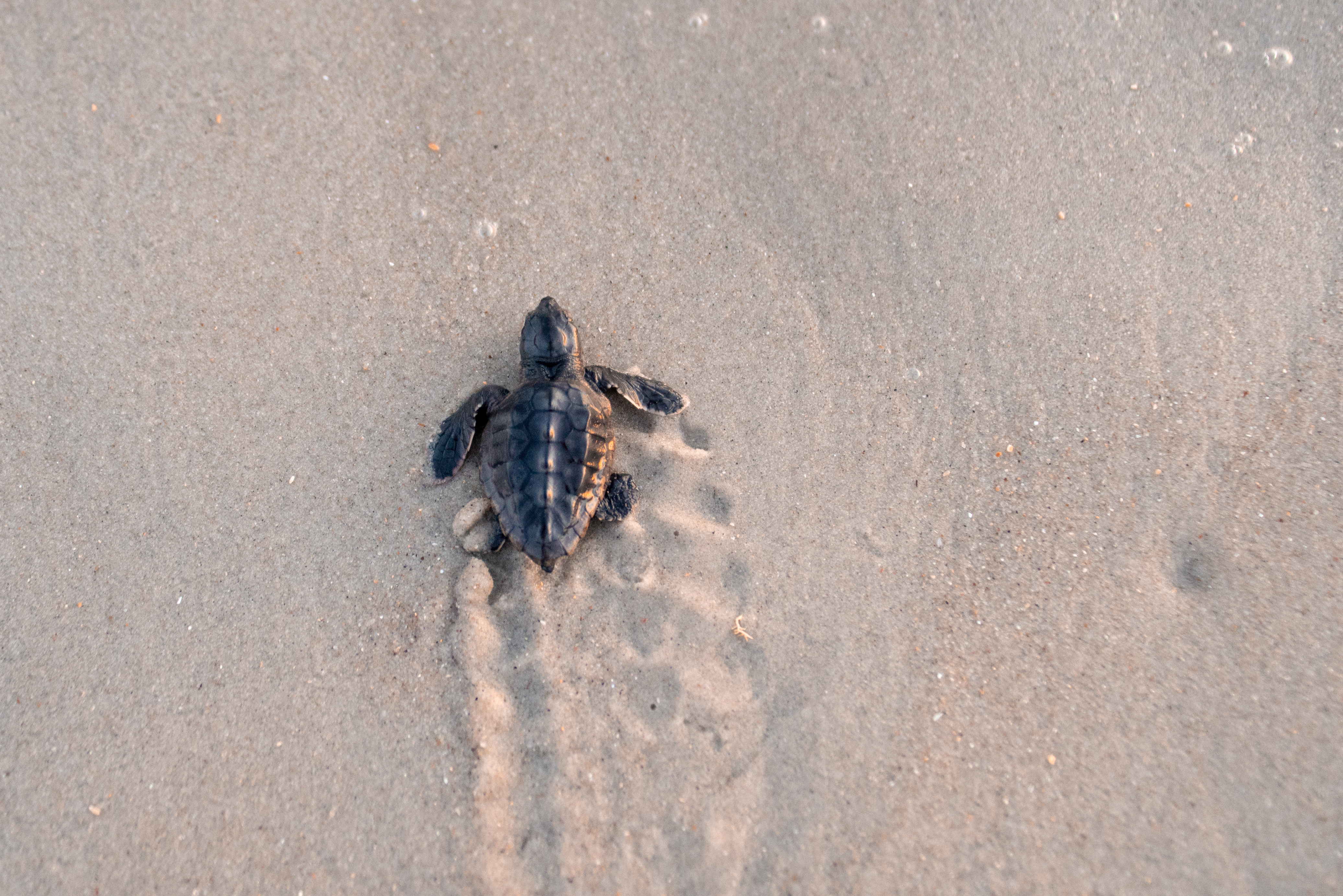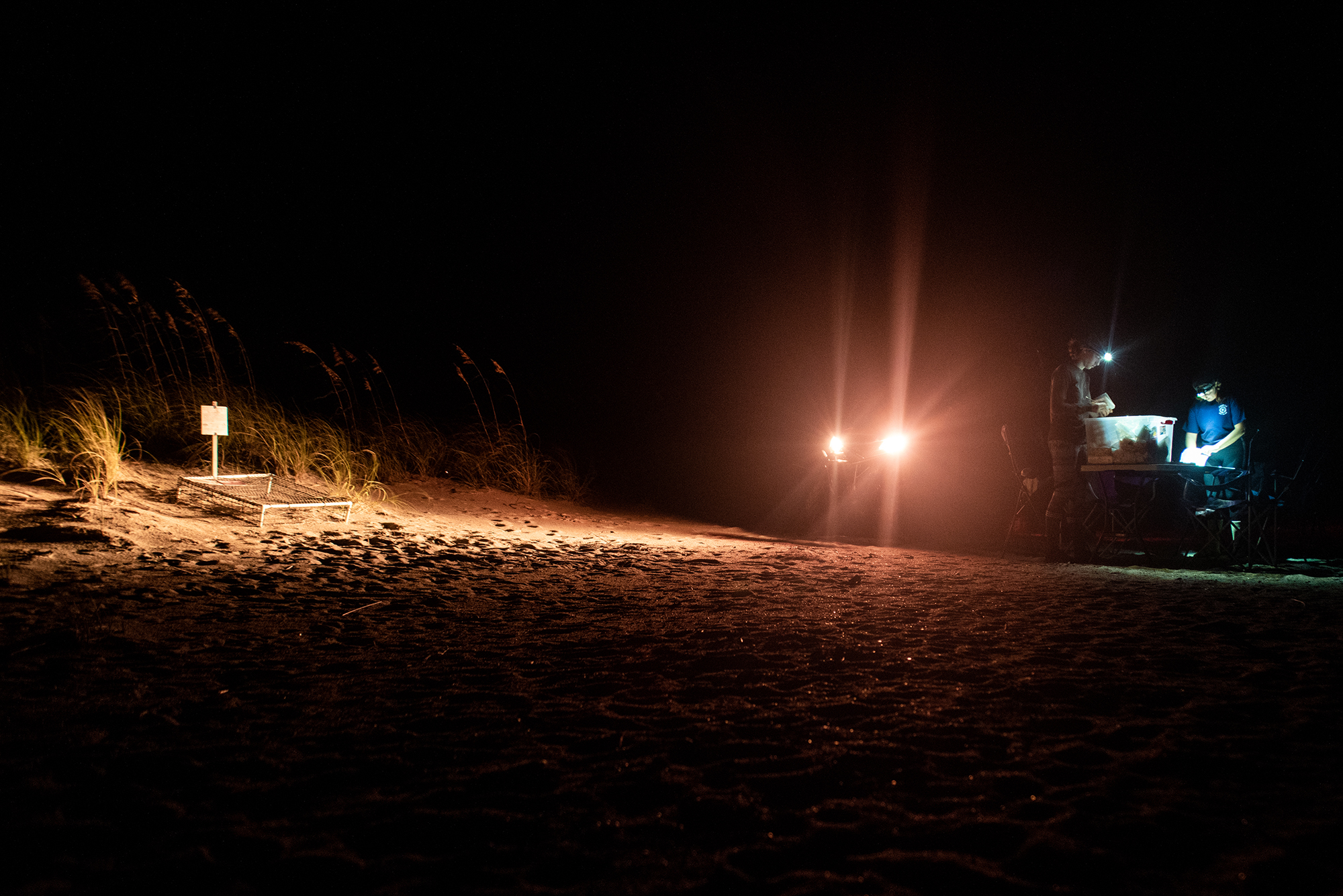It’s midnight. Kayla Goforth and her research assistants have been traveling by car, boat, and even golf cart for some seven hours to get to Bald Head Island — but the work is just beginning. They get into a utility task vehicle (UTV) and head to their field site: the nest of a loggerhead sea turtle.
A biology PhD student in Ken Lohmann’s lab at UNC, Goforth studies the magnetic orientation of loggerhead sea turtle embryos. Scientists already know these creatures navigate using a sense called magnetoreception, allowing them to detect slight fluctuations between Earth’s magnetic fields at different latitudes and longitudes. Mature turtles use this sense to return to the beach where they hatched when it’s time to mate and lay eggs.
By studying embryos’ orientations, Goforth hopes to determine if they are imprinting on the magnetic field of this natal beach. Imprinting is characterized by the rapid and ingrained learning of a geographic or social feature during a critical period in an organism’s early life — in this case, likely prior to hatching.
As the clock strikes 1 a.m., Goforth and her team of UNC undergraduates drive down the beach, right up to one of the nests she studies. It’s approximately 45 days after it was laid — close to hatching time. Conducting this field work at night prevents the eggs from being exposed to sunlight and getting too hot.
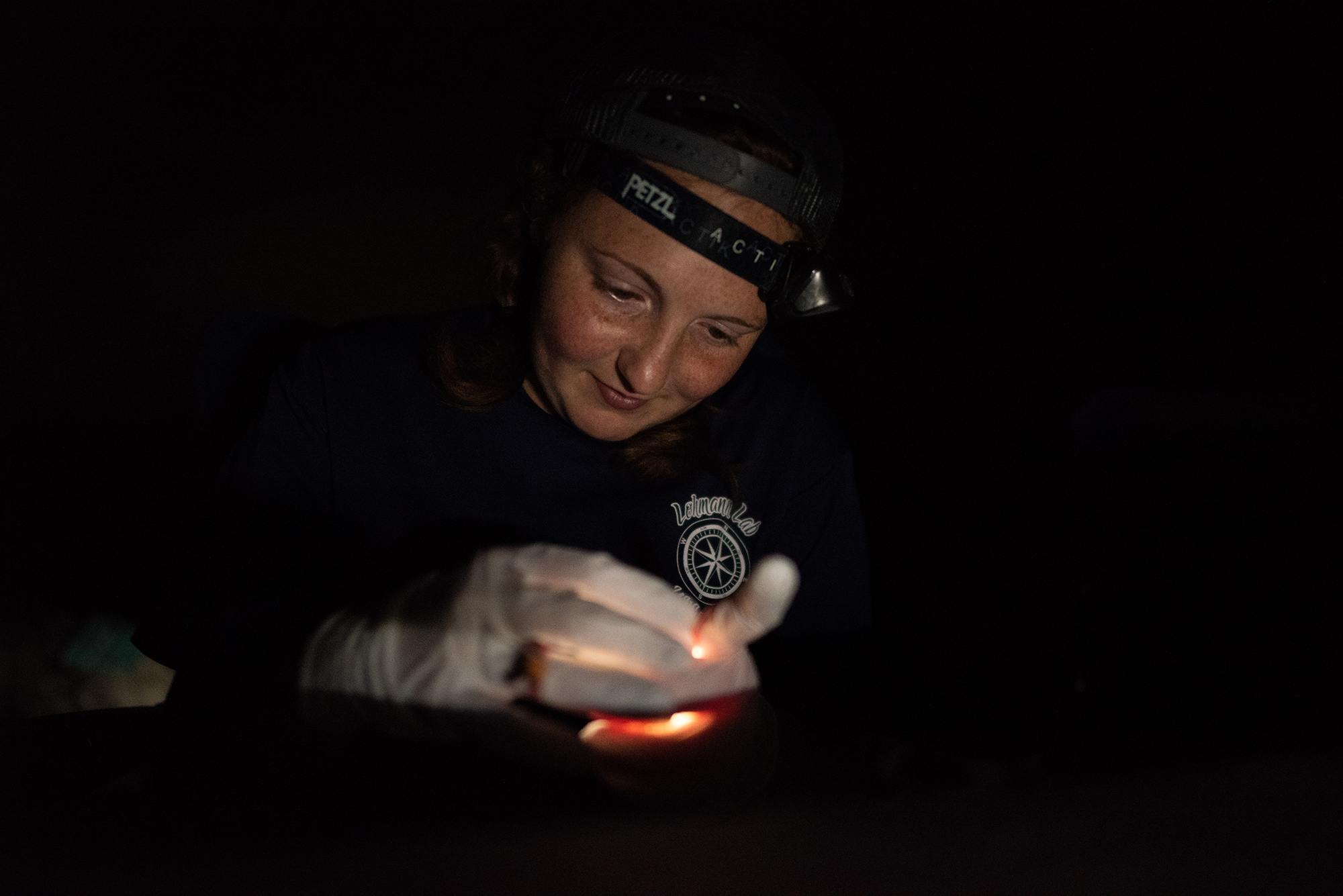 Late nights in the field don’t faze Goforth. She’s passionate about sea turtles and their environment and is particularly fascinated by their use of magnetoreception. “That’s something that we, as humans, can’t even fathom,” she says.
Late nights in the field don’t faze Goforth. She’s passionate about sea turtles and their environment and is particularly fascinated by their use of magnetoreception. “That’s something that we, as humans, can’t even fathom,” she says.
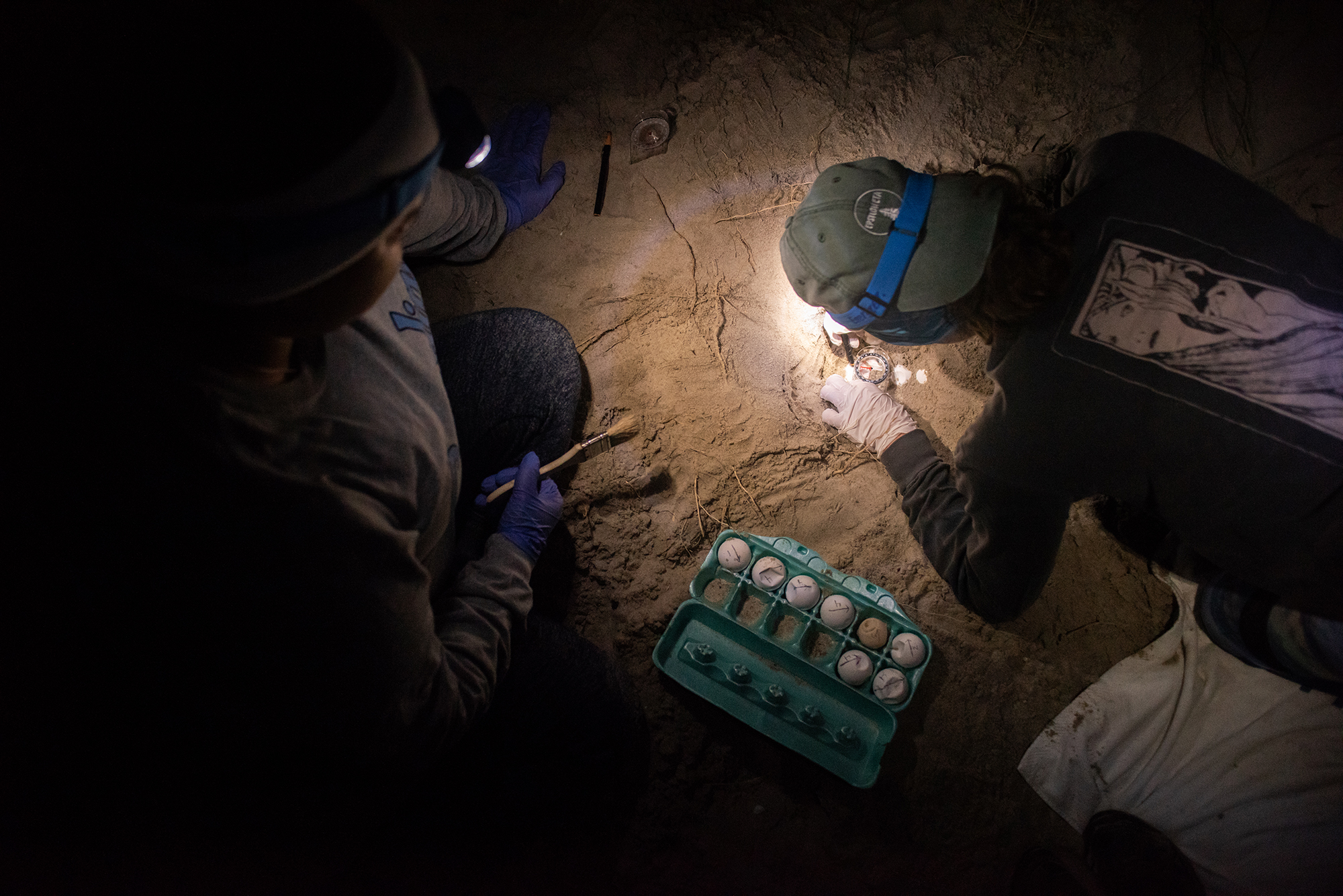 At the nest, field assistants carefully unearth the eggs, dusting off sand with a paintbrush. On top of each one, they use a black colored pencil to draw an arrow pointing toward one of the cardinal directions — north, south, east, or west. Later, Goforth will measure the angles of these arrows in relation to the directions the embryos face.
At the nest, field assistants carefully unearth the eggs, dusting off sand with a paintbrush. On top of each one, they use a black colored pencil to draw an arrow pointing toward one of the cardinal directions — north, south, east, or west. Later, Goforth will measure the angles of these arrows in relation to the directions the embryos face.
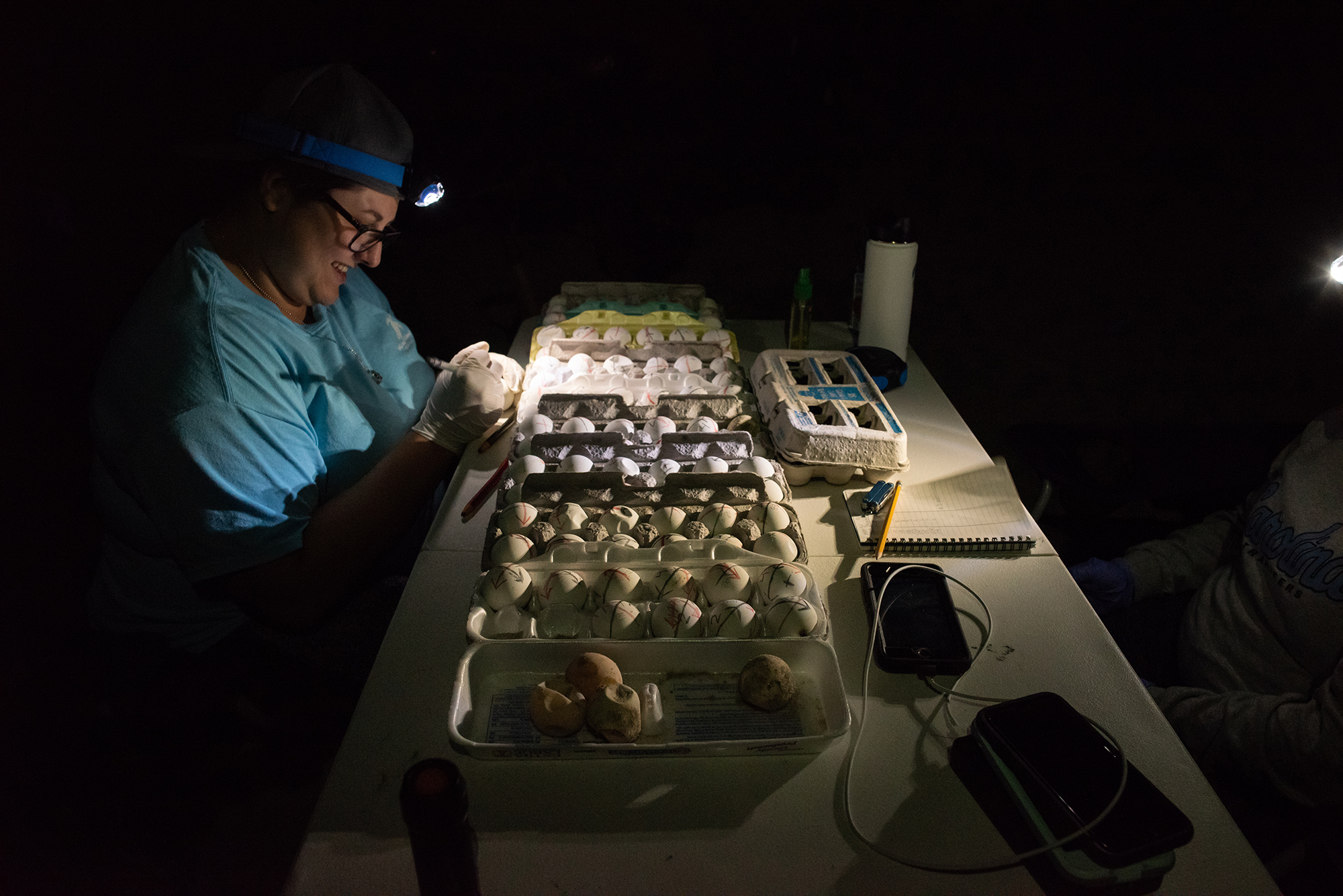 Here, one of Goforth’s research assistants, Cassidy Manzonelli, fixes lines drawn on this nest’s 112 eggs. Manzonelli is a biology major and marine science minor working in the Lohmann lab.
Here, one of Goforth’s research assistants, Cassidy Manzonelli, fixes lines drawn on this nest’s 112 eggs. Manzonelli is a biology major and marine science minor working in the Lohmann lab.
Typically, loggerheads lay around 110 to 120 eggs per nest. “They tend to lay larger eggs toward the beginning of the season and smaller eggs later in the season. The same turtle might lay up to five nests in the same summer,” Goforth explains.
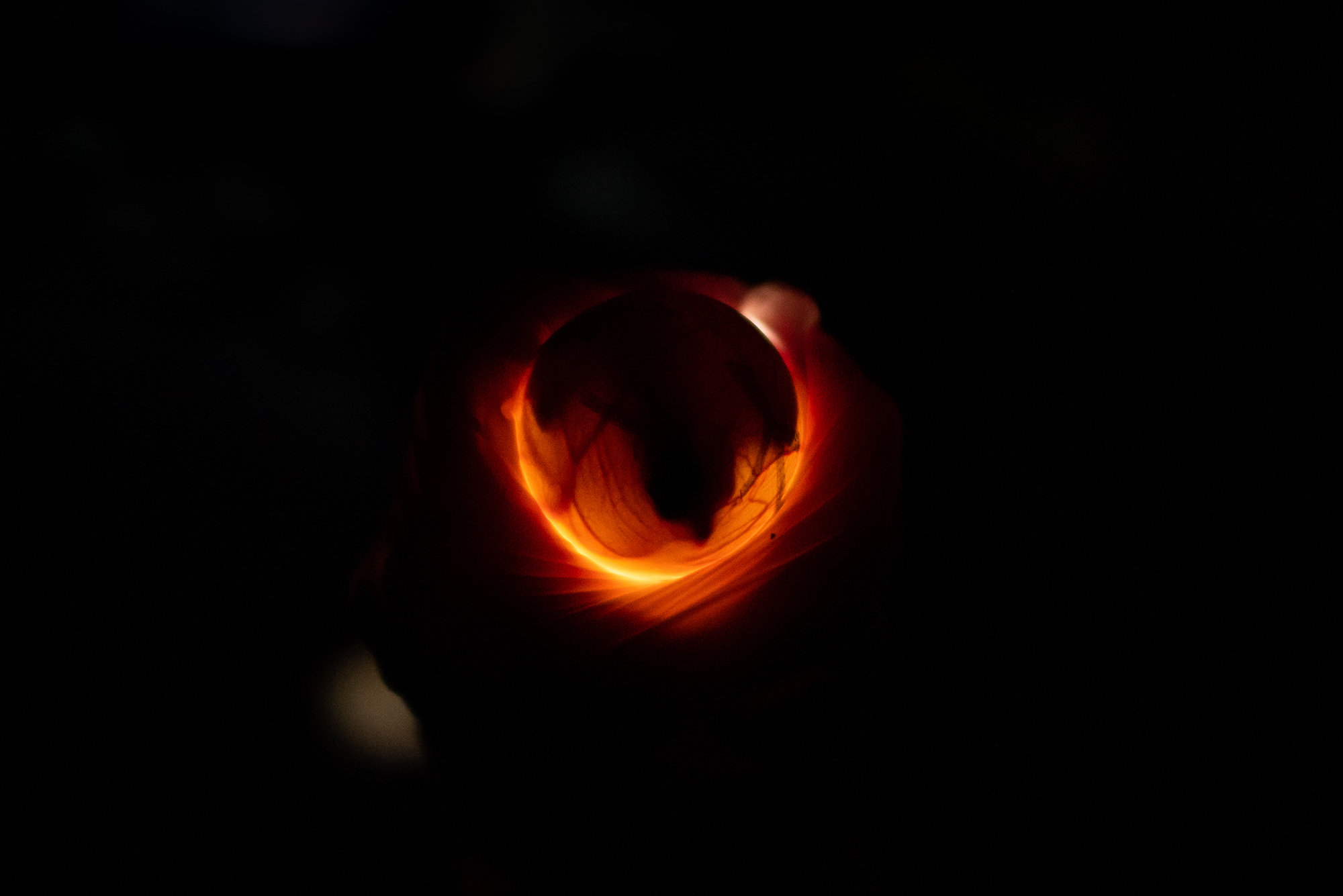 By shining a flashlight through each egg, a process called candling, Goforth observes which way the embryo faces. Here, the turtle’s head and two front flippers are visible. These baby turtles will hatch soon, and at this stage, they can be seen wiggling and shifting slightly within the egg.
By shining a flashlight through each egg, a process called candling, Goforth observes which way the embryo faces. Here, the turtle’s head and two front flippers are visible. These baby turtles will hatch soon, and at this stage, they can be seen wiggling and shifting slightly within the egg.
Goforth draws a red line from the turtle’s head to its tail, which marks its position and intersects with the black directional line drawn when the egg was first unearthed. Once both lines are drawn, the egg is photographed for later measurements.
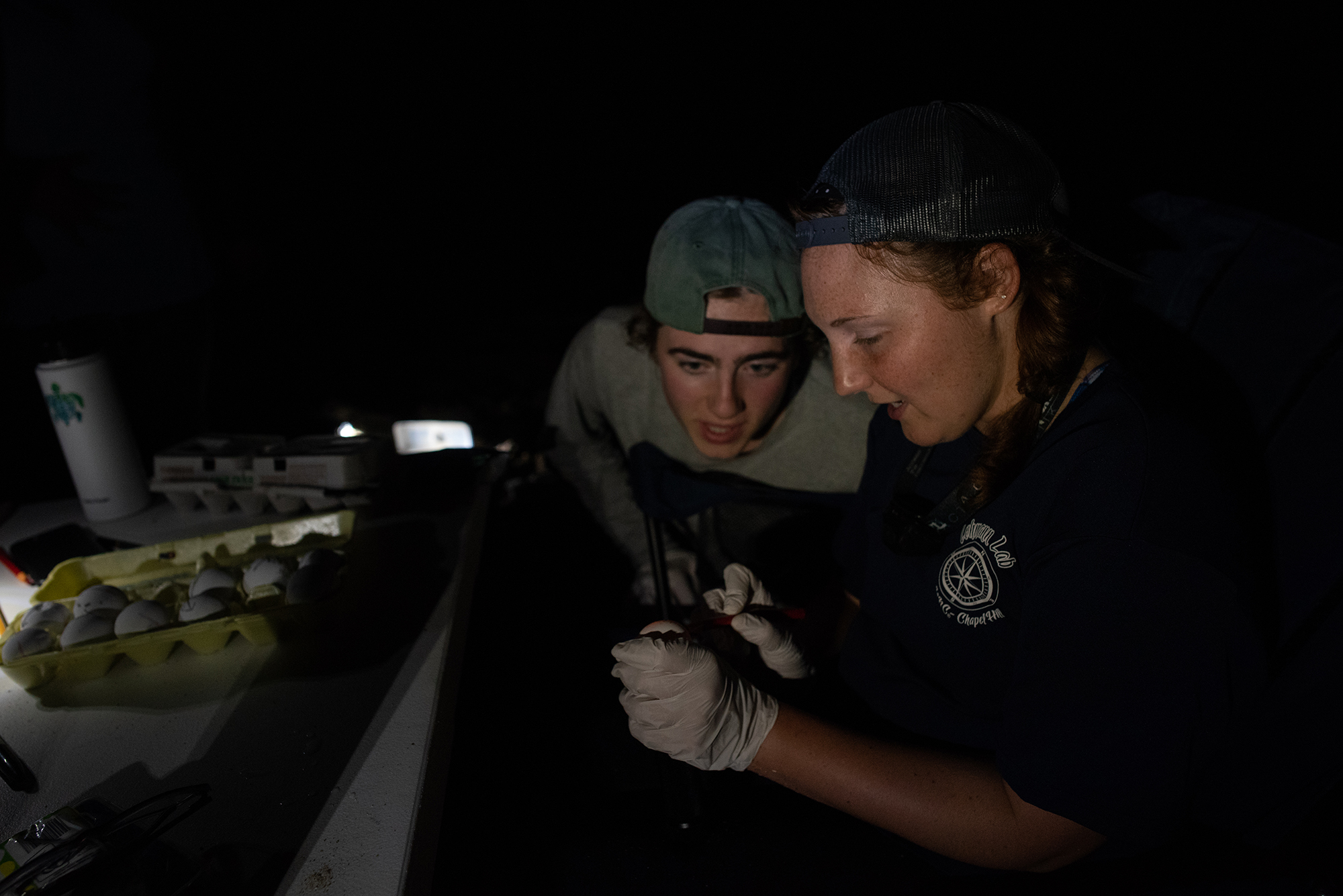 Goforth shows Caroline Koricke how to draw a line over the turtle’s position. Koricke is majoring in biology and public policy. She’s interested in the application of these fields to marine science. “My classes aren’t exactly representative of my intended career,” Koricke says. “Working with Kayla gives me a direct link to what I’m studying and what I want to be doing.”
Goforth shows Caroline Koricke how to draw a line over the turtle’s position. Koricke is majoring in biology and public policy. She’s interested in the application of these fields to marine science. “My classes aren’t exactly representative of my intended career,” Koricke says. “Working with Kayla gives me a direct link to what I’m studying and what I want to be doing.”
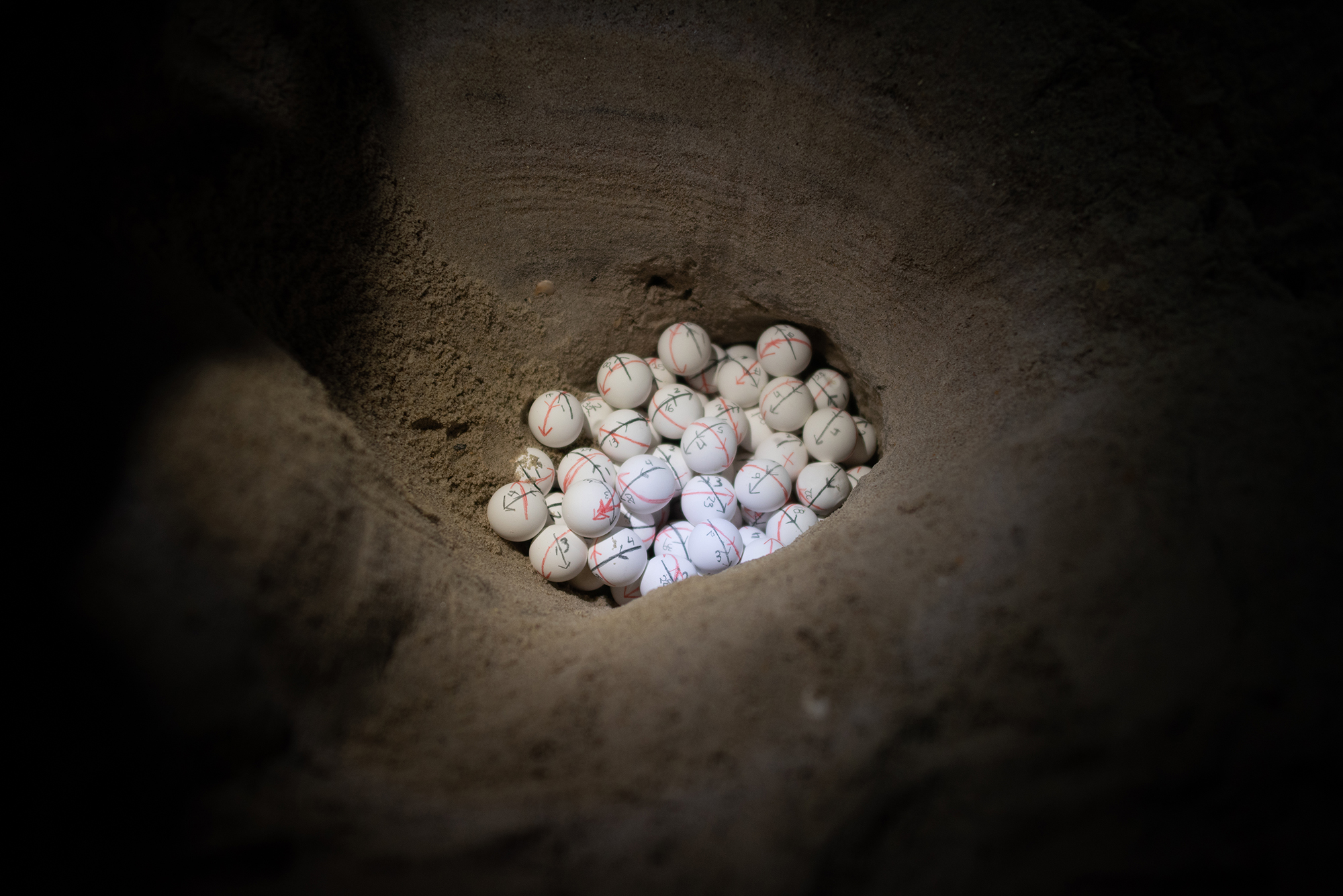 The team places the eggs back in each nest exactly how they were found — in the same order, with the same orientation. Within a week or two, sea turtle hatchlings erupt from the beach above these nests, making a beeline to the water. They use various environmental cues to begin navigating immediately.
The team places the eggs back in each nest exactly how they were found — in the same order, with the same orientation. Within a week or two, sea turtle hatchlings erupt from the beach above these nests, making a beeline to the water. They use various environmental cues to begin navigating immediately.
Baby sea turtles on the East Coast swim straight to the Gulf Stream and ride this powerful ocean current to the middle of the Atlantic. Known as the Sargasso Sea, this region is abundant with floating rafts of sargassum algae, providing food and protection for hatchlings in their early years.
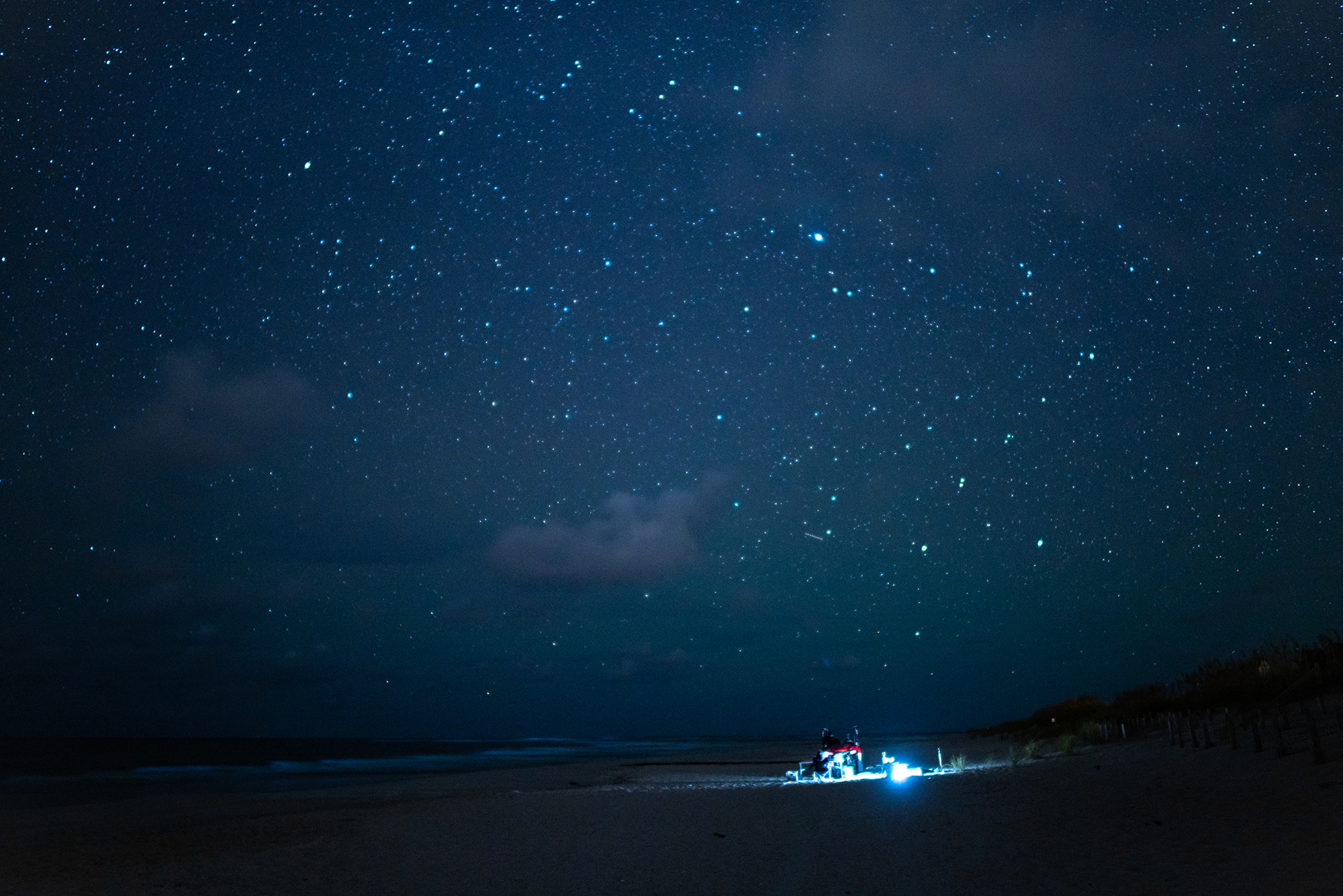 Bald Head Island boasts exceptional beauty, but the field work isn’t as glamourous as it looks. Goforth and her field assistants are often up for most of the night, digging in damp sand and being swarmed by sand flies, commonly known as “no-seeums.” When they finally get to sleep, it can be nearly sunrise.
Bald Head Island boasts exceptional beauty, but the field work isn’t as glamourous as it looks. Goforth and her field assistants are often up for most of the night, digging in damp sand and being swarmed by sand flies, commonly known as “no-seeums.” When they finally get to sleep, it can be nearly sunrise.
“I thought a couple of bugs would be no big deal, but I was sorely mistaken,” Koricke says. “It turned out to be physically difficult at times, but the research is so interesting.” To Goforth and her passionate team, science is worth the struggle.
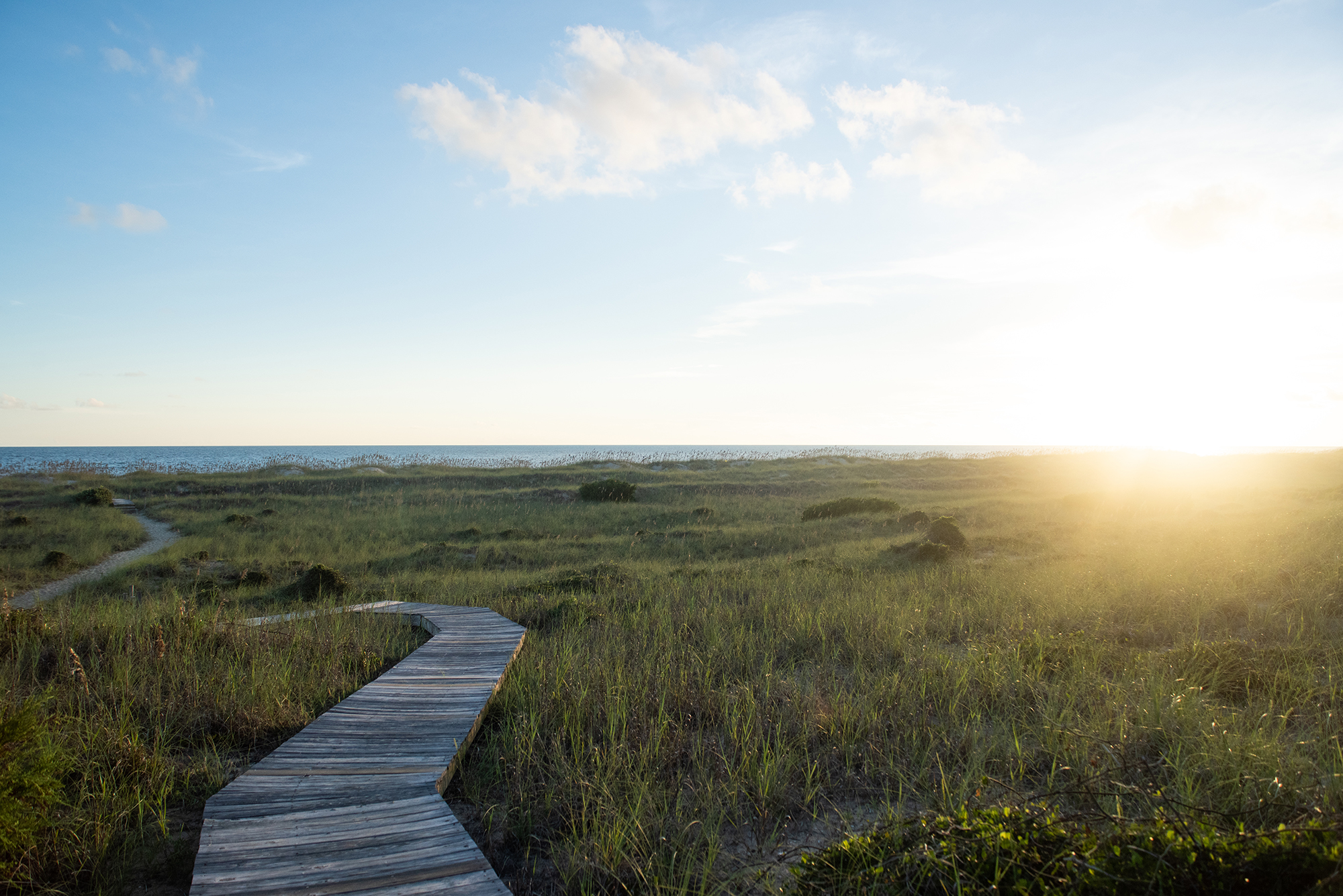 Understanding sea turtles’ lives and navigation allows scientists to better protect the species and their environment. “Knowing how and when sea turtles imprint on the magnetic field, and how that might be affected when they’re on land, can help us implement better conservation practices for the nesting areas,” Goforth says.
Understanding sea turtles’ lives and navigation allows scientists to better protect the species and their environment. “Knowing how and when sea turtles imprint on the magnetic field, and how that might be affected when they’re on land, can help us implement better conservation practices for the nesting areas,” Goforth says.
 Staff and interns at the Bald Head Island Conservancy (BHIC) excavate every nest on the island after it hatches, examining the hatching success rate and the number of unfertilized eggs. They relay the statistics for each of Goforth’s nests back to her. “All of the nests that I dug into had over 80 percent hatching success, which is really great,” Goforth shares.
Staff and interns at the Bald Head Island Conservancy (BHIC) excavate every nest on the island after it hatches, examining the hatching success rate and the number of unfertilized eggs. They relay the statistics for each of Goforth’s nests back to her. “All of the nests that I dug into had over 80 percent hatching success, which is really great,” Goforth shares.
The BHIC Sea Turtle Protection Program works with researchers like Goforth to learn more about sea turtle biology and behavior and to promote their conservation. Staff biologists like Emily Goetz collect data on the island’s nesting sea turtles and foster the success of their hatchlings. “By collaborating with scientists like Kayla and facilitating sea turtle research, we hope to use the most current data to improve our program for future years,” Goetz says.
 During excavations, the conservancy staff release turtles left behind in the nest. These events are public, so anyone can see the hatchlings make their journeys to the ocean — an experience that inspires support for sea turtle conservation.
During excavations, the conservancy staff release turtles left behind in the nest. These events are public, so anyone can see the hatchlings make their journeys to the ocean — an experience that inspires support for sea turtle conservation.
As a flagship species for their environment, sea turtles are charismatic animals that people want to protect, which, in turn, protects the environment they share with other marine life. “Actions that we all can take to help protect sea turtles — such as reducing plastic use and advocating for cleaner oceans — will benefit all marine life,” Goetz explains. “This includes the critters that don’t get as much attention as attractive species like sea turtles.”
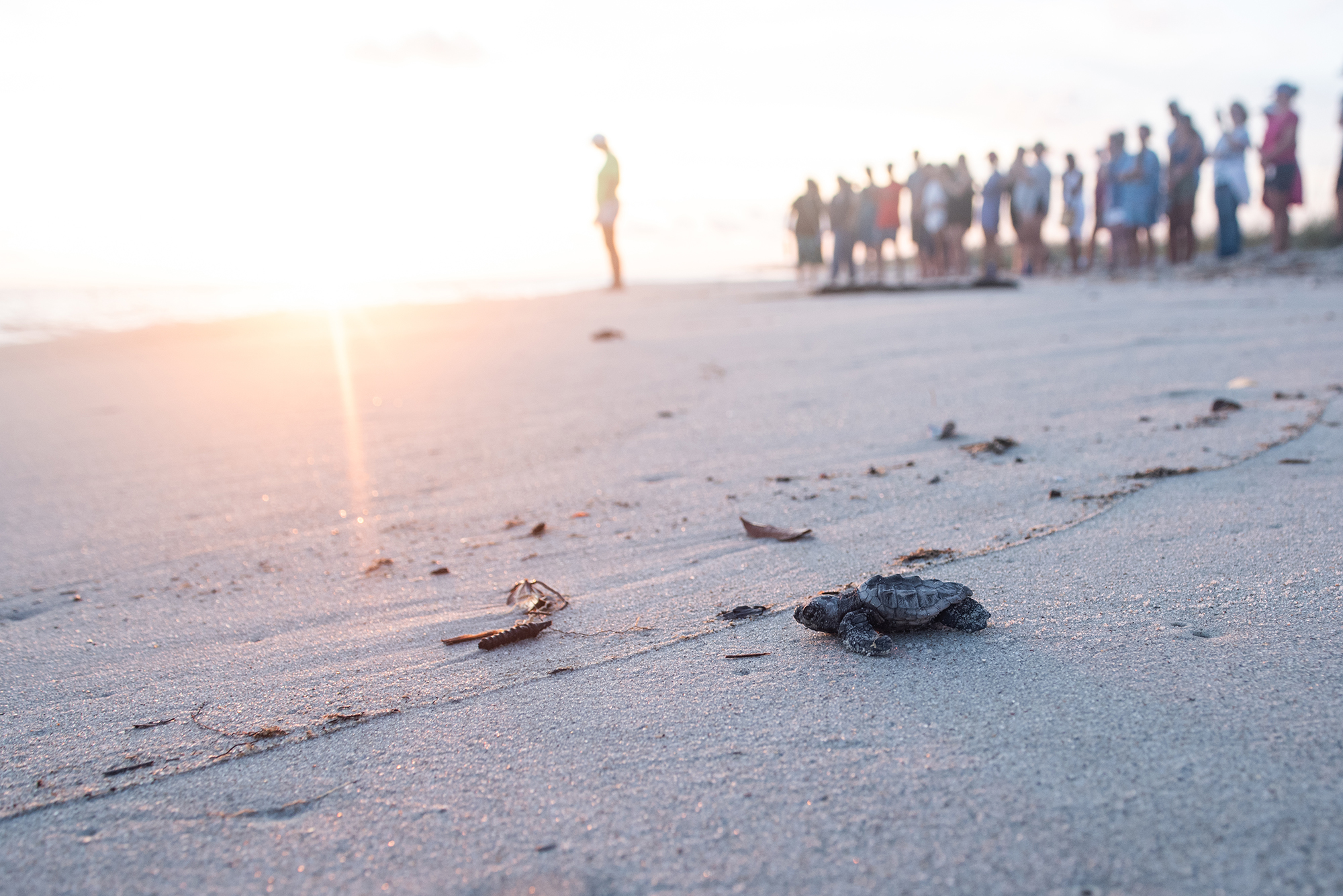 This little loggerhead turtle has a long journey ahead of her, but she’s already helped scientists like Goforth and the BHIC staff learn more about ocean conservation and her species’ extraordinary navigation. If she survives, she’ll spend decades in the Atlantic Ocean — first in open water and later in more coastal environments. Only about 1 in 1,000 sea turtles make it to adulthood, but if she’s lucky, she’ll one day use her magnetoreception to return to this beach on Bald Head Island and lay eggs of her own.
This little loggerhead turtle has a long journey ahead of her, but she’s already helped scientists like Goforth and the BHIC staff learn more about ocean conservation and her species’ extraordinary navigation. If she survives, she’ll spend decades in the Atlantic Ocean — first in open water and later in more coastal environments. Only about 1 in 1,000 sea turtles make it to adulthood, but if she’s lucky, she’ll one day use her magnetoreception to return to this beach on Bald Head Island and lay eggs of her own.


